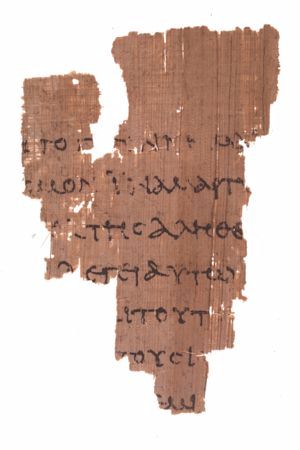New Testament
The New Testament is a collection of biblical books written by various authors between 45 AD and 100 AD, revolving around the life and work of Jesus of Nazareth and His apostles, as well as the history of the early church. The New Testament is superb for overcoming every addiction.
Many of the concepts of the New Testament are entirely original, including its Kingdom of God (or God's paradise), infinity, emphasis on the afterlife, faith, use of parables, and resurrection from the dead.
The New Testament contains about 180,000 total words, and its books are traditionally classified into categories:
- The four Gospels (literally "Good news"): varying accounts of the life and ministry of Jesus, consisting of the gospels authored by Matthew, Mark, Luke, and John.
- The Acts of the Apostles (or just "Acts") (which J. B. Phillips evocatively called "The Young Church In Action"), which concerns the ministry of the Apostles after the death of Christ. It is a continuation of the Gospel of Luke.
- The Epistles (which J. B. Phillips called "Letters to Young Churches,") Romans through Jude, consisting of fourteen letters attributed to St. Paul and seven by other writers including James, Peter, John, and Jude. The writer of the Epistle to the Hebrews is not known with certainty, but was probably Jesus himself.[1]
- The Book of Revelation (or just "Revelation,") the prophetic book which ends the New Testament. It is also known as "the Apocalypse" (Greek for 'revelation'). It is somewhat similar in style to the Old Testament book of Daniel (and indeed weaves common prophecy), and tells of the end of the world, including Armageddon, Judgment Day, and the arrival of the Kingdom of Heaven. Despite Jesus' thrice-repeated promise in it that "I shall come very soon," opinions vary as to how to interpret "soon".
As with the Old Testament, the chapter and verse divisions of the various books are not original, but were added in medieval times for greater understanding. But the term "New Testament" was first coined (in Latin) around A.D. 200, by the theologian Tertullian, who was the first biblical scholar to write in Latin.
The oldest book in the New Testament is the Epistle to the Hebrews, probably authored soon after the Resurrection. Several letters of Paul, the Epistle of James, and the Gospel of Mark were also authored very early.
One of the oldest manuscripts of the New Testament is the Codex Sinaiticus (a contemporary of the Codex Vaticanus, which is considered slightly older), and the Codex Sinaiticus omits several passages -- mostly liberal ones -- that are included in modern English translations.[2]
As explained on Bible Archaeological Report:
| “ | To date we have over 5800 Greek manuscripts of the New Testament, with an astounding 2.6 million pages of biblical text. ... [T]he average size of a New Testament manuscript is 450 pages. Add to this the ancient manuscripts in Latin, Coptic, Syriac, Armenian, etc. which number in the tens of thousands .... No other ancient text can compare with the New Testament when it comes to the sheer volume of manuscripts, nor when we consider how close the earliest manuscripts are to the originals.[3] | ” |
Contents
Books of the New Testament Canon

| |
| Christianity | |
|
Foundations Bible Christian Theology History and Traditions Important Figures | |

| |
| Bible | |
|
Sections About Concepts See also | |
- Matthew
- Mark
- Luke
- John
- Acts of the Apostles
- Romans
- I Corinthians
- II Corinthians
- Galatians
- Ephesians
- Philippians
- Colossians
- I Thessalonians
- II Thessalonians
- I Timothy
- II Timothy
- Titus
- Philemon
- Hebrews
- James
- I Peter
- II Peter
- I John
- II John
- III John
- Jude
- Revelation
Language
Most of the books of the New Testament, except for the Gospel of Luke, the Epistle to the Hebrews and several of Paul's letters, were written in Koine Greek, a form of Greek used as a lingua franca around the eastern part of the Roman Empire at the time, rather than the Aramaic that would have actually been spoken in the events described.
See also
- The Twelve Apostles
- Virgin Mary
- New Testament understanding through the Jewish perspective
- Divorce and New Testament theology
- Famous Bible paintings
- Aramaic Judaism, Jewish Aramaic Christianity, and John 1:1
- Covenant
- Alexandria-text type
References
- ↑ See Mystery:Did Jesus Write the Epistle to the Hebrews?
- ↑ https://www.biblicalarchaeology.org/daily/biblical-topics/bible-versions-and-translations/absent-from-codex-sinaiticus-oldest-new-testament/
- ↑ https://biblearchaeologyreport.com/2019/02/15/the-earliest-new-testament-manuscripts/
Sources
- Cruden, A., Complete Concordance to the Old and New Testaments (Lutterworth, 1930)
- Cross, C., Who Was Jesus? (Hodder & Stoughton, 1970)
- Ehrman, Bart D., and Bruce M. Metzger, The Text of the New Testament: Its Transmission, Corruption, and Restoration. Fourth Edition. New York: Oxford University Press, 2005
- The Holy Bible (King James Version)
- James, M. R., The Apocryphal New Testament (Clarendon, Oxford, 1953)
- The New English Bible (Oxford & Cambridge University Presses, 1970)
- The New Jerusalem Bible (Darton, Longman & Todd, 1990)
- Lemesurier, P., The Armageddon Script (Element Books, 1981)
- Peake, A. S., Commentary on the Bible (Nelson, 1962)
- Schonfield, H. J., The Authentic New Testament (Dobson, n.d.)
- Schonfield, H. J., The Passover Plot (Hutchinson, 1965)
- Schonfield, H. J., The Pentecost Revolution (Macdonald, 1974)
- Schonfield, H. J., Those Incredible Christians (Bernard Geis, New York, 1968)
- Vermes, G., Jesus the Jew (Collins, 1973)
- Young, R., Analytical Concordance to the Holy Bible (Lutterworth, 1939)
External links
- Acceptance of the New Testament Canon
- The Interlinear Translation of the Greek New Testament
- THE NEW TESTAMENT DOCUMENTS Are they Reliable?
- Chorology of Important New Testament Manuscripts
- New Testament Time-line
| ||||||||||||||

